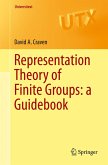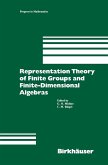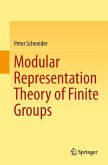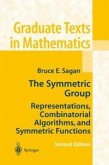Representation Theory of Finite Groups presents group representation theory at a level accessible to advanced undergraduate students and beginning graduate students. The required background is maintained to the level of linear algebra, group theory, and very basic ring theory and avoids prerequisites in analysis and topology by dealing exclusively with finite groups. Module theory and Wedderburn theory, as well as tensor products, are deliberately omitted. Instead, an approach based on discrete Fourier Analysis is taken, thereby demanding less background from the reader.
The main topics covered in this text include character theory, the group algebra and Fourier analysis, Burnside's pq-theorem and the dimension theorem, permutation representations, induced representations and Mackey's theorem, and the representation theory of the symmetric group. For those students who have an elementary knowledge of probability and statistics, a chapter on random walks onfinite groups serves as an illustration to link finite stochastics and representation theory. Applications to the spectral theory of graphs are given to help the student appreciate the usefulness of the subject and the author provides motivation and a gentle style throughout the text. A number of exercises add greater dimension to the understanding of the subject and some aspects of a combinatorial nature are clearly shown in diagrams.
This text will engage a broad readership due to the significance of representation theory in diverse branches of mathematics, engineering, and physics, to name a few. Its primary intended use is as a one semester textbook for a third or fourth year undergraduate course or an introductory graduate course on group representation theory. The content can also be of use as a reference to researchers in all areas of mathematics, statistics, and several mathematical sciences.
The main topics covered in this text include character theory, the group algebra and Fourier analysis, Burnside's pq-theorem and the dimension theorem, permutation representations, induced representations and Mackey's theorem, and the representation theory of the symmetric group. For those students who have an elementary knowledge of probability and statistics, a chapter on random walks onfinite groups serves as an illustration to link finite stochastics and representation theory. Applications to the spectral theory of graphs are given to help the student appreciate the usefulness of the subject and the author provides motivation and a gentle style throughout the text. A number of exercises add greater dimension to the understanding of the subject and some aspects of a combinatorial nature are clearly shown in diagrams.
This text will engage a broad readership due to the significance of representation theory in diverse branches of mathematics, engineering, and physics, to name a few. Its primary intended use is as a one semester textbook for a third or fourth year undergraduate course or an introductory graduate course on group representation theory. The content can also be of use as a reference to researchers in all areas of mathematics, statistics, and several mathematical sciences.
Dieser Download kann aus rechtlichen Gründen nur mit Rechnungsadresse in A, B, BG, CY, CZ, D, DK, EW, E, FIN, F, GR, HR, H, IRL, I, LT, L, LR, M, NL, PL, P, R, S, SLO, SK ausgeliefert werden.
From the reviews: "Steinberg ... provides a one-semester course on representation theory with just linear algebra and a beginning course in abstract algebra (primarily group theory) as prerequisites. ... the author covers most of the standard introductory topics in representation theory. The exercises provide more examples and further common results. It is the applications that Steinberg uses to motivate the subject that make this text both interesting and valuable. ... Overall, a very user-friendly text with many examples and copious details. Summing Up: Recommended. Upper-division undergraduates through researchers/faculty." (J. T. Zerger, Choice, Vol. 49 (11), August, 2012) "The book consists of 157 pages spread over 11 chapters. ... This book is an introductory course and it could be used by mathematicians and students who would like to learn quickly about the representation theory and character theory of finite groups, and for non-algebraists, statisticians and physicists who use representation theory." (Jamshid Moori, Mathematical Reviews, Issue 2012 j) "The required background as to this introductory course on group representations, is in the level of linear algebra, group theory and some ring theory. ... the book under review is a welcome one for students at an advanced undergraduate or introductory graduate level course, also for those people like physicists, statisticians and non-algebraically oriented mathematicians who need representation theory in their work." (R. W. van der Waall, Zentralblatt MATH, Vol. 1243, 2012) "The author has, by combining clear writing with an accessible and minimal-prerequisite approach to group representations, created a book that may well help bring group representation theory into the undergraduate curriculum. This is an impressive and useful text, and should be looked at by anybody with an interest in the subject." (Mark Hunacek, The Mathematical Association of America, February, 2012)









